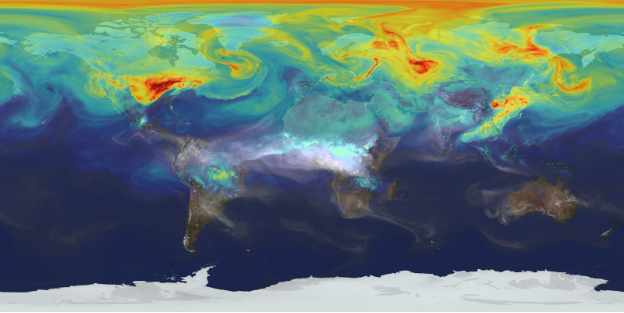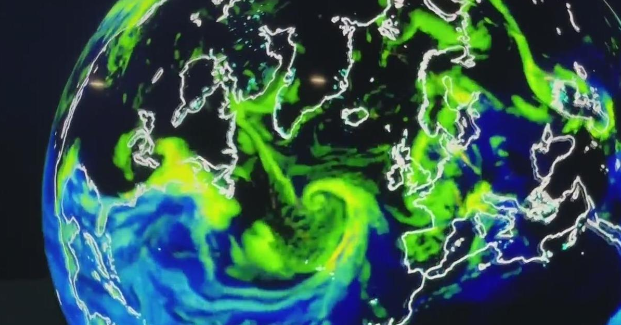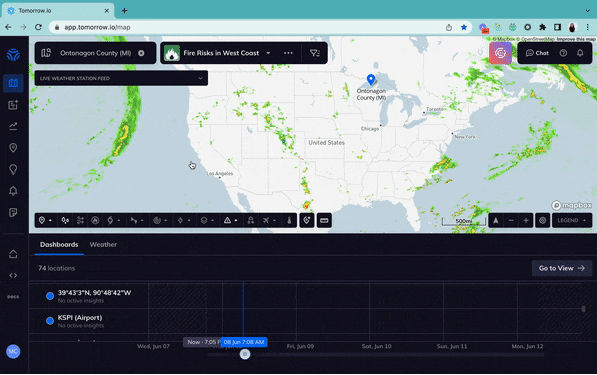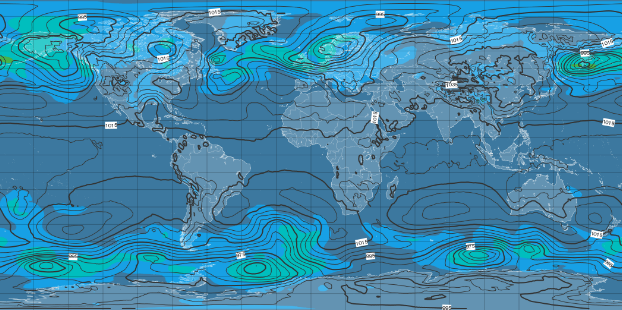In the vast expanse of our planet's oceans, hurricanes emerge as titanic forces of nature, wielding the power to reshape coastlines and redefine communities. While awe-inspiring, these swirling tempests bring a trail of destruction, impacting both human lives and economies. As the world grapples with the escalating threats of climate change, the frequency and intensity of these hurricanes are under intense scrutiny. Now, more than ever, there's an imperative need for accurate prediction and timely management of these meteorological giants.
Enter the realm of technology, where advancements in weather prediction models and the advent of Weather APIs are revolutionizing our approach to hurricane tracking and management. This article delves deep into the confluence of climate change, the science of hurricane prediction, and the pivotal role of Weather APIs, offering insights into how we can better prepare for and respond to the tempestuous challenges posed by nature.
1. The Changing Dynamics of Hurricanes in the Age of Climate Change
The intricate dance between our planet's atmosphere and its oceans has birthed hurricanes for millennia. However, as the world warms, the choreography of this dance is undergoing a transformation, leading to shifts in the frequency, intensity, and behavior of these storms.

1.1. The Link Between Climate Change and More Frequent/Intense Hurricanes
Climate change, driven primarily by human activities, has led to a rise in global temperatures. This warming extends to the oceans, which serve as the birthplace of hurricanes. Warmer waters provide more energy, acting as fuel for these storms, leading to not only a potential increase in their number but also in their intensity. Studies have shown that the likelihood of more devastating Category 4 and 5 hurricanes is on the rise, posing greater threats to coastal communities.
1.2. Historical Data vs. Recent Trends in Hurricane Activity
Historically, hurricane patterns have shown natural variability. However, recent decades have witnessed anomalies that can't be explained by natural cycles alone. The last two decades have seen some of the most active hurricane seasons on record. While it's challenging to attribute any single hurricane to climate change, the overarching trend of more powerful and wetter storms aligns with climate predictions.
1.3. The Implications of Climate Change on Coastal Communities and Economies
The devastation they leave in their wake escalates as hurricanes grow in strength. Coastal communities, often the first line of defense against these storms, face existential threats. Rising sea levels, another consequence of climate change, exacerbate storm surges, leading to more severe flooding. Economies, too, bear the brunt. From damaged infrastructure and lost livelihoods to skyrocketing insurance costs, the economic toll of these enhanced storms is profound. For instance, the Caribbean, a region frequently in the path of hurricanes, faces significant economic setbacks almost annually, with recovery often taking years.
2. The Science Behind Weather Prediction Models
The art of predicting the weather, especially phenomena as complex as hurricanes, is a culmination of data, technology, and intricate algorithms. As we stand on the cusp of technological advancements, our ability to foresee and understand hurricanes has never been more refined.

2.1. Basics of Meteorological Data Collection: Satellites, Buoys, and Weather Stations
The foundation of any weather prediction lies in the vast array of data collected every moment. Satellites orbiting the Earth capture real-time images and data, tracking cloud formations, temperature fluctuations, and atmospheric changes. Floating on the world's oceans, Buoys relay information about sea surface temperatures and wave heights, crucial for understanding the genesis of hurricanes. Weather stations scattered globally on land measure parameters like air pressure, humidity, and wind speed. Together, these instruments provide a holistic view of our planet's meteorological conditions.
2.2. How Prediction Models Work: From Data Collection to Forecasting
Once data is collected, it's fed into sophisticated computer models designed to simulate the Earth's atmosphere and oceans. These models, based on the principles of physics and meteorology, crunch vast amounts of data to produce forecasts. For hurricanes, models predict the storm's path, intensity, and potential landfall. The accuracy of these predictions often hinges on the quality and quantity of the input data and the model's resolution.
2.3. The Evolution of Prediction Models Over the Years
Historically, weather predictions were based on observational data and rudimentary calculations. However, with the advent of supercomputers and advancements in meteorological science, prediction models have evolved significantly. Today's models, such as the European Centre for Medium-Range Weather Forecasts (ECMWF) or the American Global Forecast System (GFS), can provide forecasts up to several days in advance with remarkable accuracy.
2.4. Challenges in Predicting Hurricanes and the Role of Supercomputers
Despite advancements, predicting hurricanes remains a formidable challenge. The inherent unpredictability of weather, coupled with factors like changing sea temperatures due to climate change, adds layers of complexity. Supercomputers play a pivotal role here. With their immense processing power, they run multiple simulations, factoring in various scenarios to provide a range of possible outcomes. This ensemble approach increases the reliability of predictions, giving meteorologists a better understanding of potential hurricane paths and intensities.
3. Weather APIs: The Unsung Heroes in Hurricane Management
In today's digital age, where data drives decisions, Weather APIs have emerged as powerful tools in the realm of hurricane management. These APIs serve as bridges, connecting vast meteorological databases to applications and systems that require real-time weather information. (Source: Tomorrow.io weather API)

3.1. Introduction to Weather APIs: What are they and how do they work?
Weather APIs are sets of protocols and tools that allow different software applications to communicate with weather databases. They provide structured access to vast amounts of meteorological data, from current conditions to forecasts. Developers can integrate these APIs into various platforms, ensuring that accurate and timely weather information is always at the fingertips of end-users.
3.2. Real-time Monitoring and Prediction: How APIs provide up-to-the-minute data
One of the standout features of Weather APIs is their ability to deliver real-time data. As conditions change, especially during the rapid development of a hurricane, these APIs provide continuous updates. This ensures that forecasters, emergency responders, and the public have the most current information available, enhancing decision-making during critical moments.
3.3. Tracking Path and Intensity: The Role of APIs in Mapping Hurricane Trajectories
Through integration with advanced prediction models, Weather APIs can offer detailed insights into a hurricane's projected path and intensity. Users can access visual representations, like maps showing the storm's trajectory, areas of potential landfall, and regions that might experience the highest wind speeds or storm surges.
3.4. Alerts and Notifications: Automated Systems To Warn Populations at Risk
Weather APIs can be integrated into alert systems, ensuring at-risk populations receive timely warnings. Whether it's a mobile app sending push notifications or a public announcement system broadcasting alerts, these APIs ensure that warnings are based on the latest data, maximizing the time available for preparations or evacuations.
3.5. Historical Data Analysis: Using Past Data To Predict Future Hurricane Behavior
Beyond real-time data, Weather APIs also provide access to historical weather records. This treasure trove of past data is invaluable for researchers studying hurricane patterns. By analyzing past hurricanes, their paths, and intensities, scientists can identify trends and refine prediction models, enhancing their accuracy for future events.
3.6. Safety Recommendations and Integration: How APIs Can Be More than just Data Providers
Advanced Weather APIs go beyond mere data provision. They can offer safety recommendations based on current conditions. For instance, during a hurricane warning, the API might suggest evacuation routes, provide checklists for hurricane preparedness, or offer guidelines on securing properties. Furthermore, their integration capabilities mean they can work in tandem with other systems, from traffic management to emergency services, ensuring a coordinated response during a hurricane.
4. The Synergy Between Climate Change Awareness and Technological Advancements
In the face of escalating hurricane threats, understanding the interplay between climate change and technological advancements becomes paramount. This synergy holds the potential to reshape our approach to hurricane preparedness and response, ensuring that we are better equipped to face the challenges of tomorrow.

4.1. How Understanding Climate Change Can Improve Prediction Models
Awareness of climate change and its impacts on hurricane behavior provides invaluable context for refining weather prediction models. As we recognize the more frequent and intense hurricane patterns, models can be adjusted to account for these new norms. For instance, if warmer ocean temperatures are leading to stronger hurricanes, prediction models can be tweaked to factor in this correlation, enhancing their accuracy.
4.2. The Role of Technology in Mitigating the Effects of Climate Change
While technology plays a crucial role in predicting hurricanes, its potential in mitigating the effects of climate change is equally significant. Advanced technologies, such as green energy solutions, carbon capture, and reforestation efforts, can help reduce the human-induced factors driving climate change. Moreover, technology can aid in building resilient infrastructures, ensuring that communities are better prepared to withstand the brunt of powerful hurricanes.
4.3. Future Prospects: What Advancements Can We Expect in the Realm of Weather Prediction and Hurricane Management?
As we look to the future, the marriage of technology and climate science promises even more refined tools for hurricane prediction and management. We can anticipate the development of hyper-local prediction models, offering block-by-block forecasts. The integration of artificial intelligence and machine learning with weather prediction models could provide real-time adjustments based on live data feeds. Additionally, the rise of the Internet of Things (IoT) means that a network of interconnected devices could offer instant data from the ground, further refining our understanding and response to hurricanes.
Conclusion
Hurricanes, with their awe-inspiring might and devastating impact, stand as a testament to nature's unpredictable power. In an era marked by the dual challenges of escalating climate change and its resultant intensification of hurricanes, our reliance on technology has never been more pronounced. Through the lens of advanced weather prediction models and the transformative potential of Weather APIs, we've explored the frontiers of our current understanding and response mechanisms to these meteorological giants.
In closing, the journey to understanding and managing hurricanes is ongoing, marked by continuous learning and adaptation. But with each storm weathered and each challenge overcome, we move a step closer to a world where the harmony between humanity and nature is restored.
© 2025 NatureWorldNews.com All rights reserved. Do not reproduce without permission.





